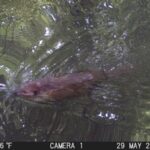Beaver Tales
Impressed with the beaver’s aquatic engineering skills, the Algonquin peoples called them “the Old Wise Ones.”It was believed that the beaver had once been a large, intelligent, and speaking creature who was demoted to a dumb animal by a Deity nervous about their competing with humankind. (So much so that up around Lake Huron it was even said that beavers once hunted humans, not the other way around.)Though downsized and deprived of speech, the beaver nevertheless was allowed to keep its native wisdom.
While they hunted and trapped the beaver, the Algonquin people accorded them special respect. The beaver’s bones were never to be given to the village dogs to gnaw on like other animal remains: any hunter who did so was likely to have bad luck with future hunts.Instead the bones were to be burned or thrown into the water to help make new beavers.Likewise the beaver’s blood was never to be spilled on the ground, but returned with the bones to the waters from whence the beaver came.
Roasted beaver tails were considered a special treat, but to the Native Americans the beaver was especially valued as a means of obtaining the all but priceless metal, glass, and other goods the Europeans manufactured.To this day the classic woolen Hudson Bay blankets are still made with black hash marks inked on one corner to indicate the blanket’s cost in beaver pelts (a full sized one will set you back four beavers.)“The beaver does everything perfectly well,” a Cree once remarked. “It makes kettles, hatchets, swords, knives, bread: in short, it makes everything.
S.P. DeVillo





